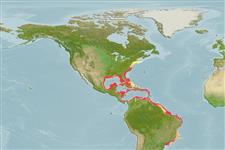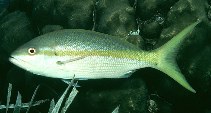個人による観察記録の追加 Fish Watcher
| Native range | All suitable habitat | Point map | Year 2050 |

|
| This map was computer-generated and has not yet been reviewed. |
| Ocyurus chrysurus AquaMaps Data sources: GBIF OBIS |
Upload your 写真 and ビデオ
Pictures | Videos | Sounds | Stamps, coins, misc. | グーグルの画像Ocyurus chrysurus
Picture by Randall, J.E.
Pictures | Videos | Sounds | Stamps, coins, misc. | グーグルの画像Ocyurus chrysurus
Picture by Randall, J.E.
Venezuela country information
Common names:
Rabirrubia
Occurrence: native
Salinity: marine
Abundance: common (usually seen) | Ref: Cervigón, F., 1993
Importance: commercial | Ref:
Aquaculture: | Ref:
Regulations: | Ref:
Uses: no uses
Comments: Encountered on the Venezuelan coast and in insular areas with coral reefs (Ref. 9626). Important catch in Los Roques and La Tortuga (Ref. 9626). Also Ref. 5217, 9987.
National Checklist:
Country Information: https://www.cia.gov/library/publications/resources/the-world-factbook/geos/ve.html
National Fisheries Authority:
Occurrences: Occurrences Point map
Main Ref: Allen, G.R., 1985
National Database:
Occurrence: native
Salinity: marine
Abundance: common (usually seen) | Ref: Cervigón, F., 1993
Importance: commercial | Ref:
Aquaculture: | Ref:
Regulations: | Ref:
Uses: no uses
Comments: Encountered on the Venezuelan coast and in insular areas with coral reefs (Ref. 9626). Important catch in Los Roques and La Tortuga (Ref. 9626). Also Ref. 5217, 9987.
National Checklist:
Country Information: https://www.cia.gov/library/publications/resources/the-world-factbook/geos/ve.html
National Fisheries Authority:
Occurrences: Occurrences Point map
Main Ref: Allen, G.R., 1985
National Database:
Common names from other countries
分類 / Names 共通名の | 類義語 | Catalog of Fishes(部類, 種) | ITIS | CoL | WoRMS | Cloffa
> Eupercaria/misc (Various families in series Eupercaria) > Lutjanidae (Snappers) > Lutjaninae
Etymology: Ocyurus: Greek, okys = quick + Greek, oura = tail.
More on author: Bloch.
Etymology: Ocyurus: Greek, okys = quick + Greek, oura = tail.
More on author: Bloch.
Environment: milieu / climate zone / depth range / distribution range 生態学
海 関連する礁; 深さの範囲 0 - 180 m (Ref. 10795), usually 10 - 70 m (Ref. 55229). Subtropical; 42°N - 26°S, 98°W - 31°W (Ref. 55229)
分布 国々 | 国連食糧農業機関の区域 | エコシステム | 事件 | Point map | 導入 | Faunafri
Western Atlantic: extending northward to Massachusetts, USA and Bermuda and southward to southeastern Brazil, in Gulf of Mexico and Antilles (Anderson, pers. comm.). Most common in the Bahamas, off south Florida and throughout the Caribbean. Lutjanus ambiguus (Poey, 1860), an intergeneric hybrid with Lutjanus synagris (Linnaeus) as demonstrated by Loftus (1992: Ref. 33006), followed by McEachran &. Fechhelm (2005: Ref. 78464).
Length at first maturity / サイズ / 重さ / 年齢
Maturity: Lm 23.8, range 14 - 31 cm
Max length : 86.3 cm TL オス/雌雄の選別がない; (Ref. 9626); common length : 40.0 cm TL オス/雌雄の選別がない; (Ref. 55); 最大公表体重: 4.1 kg (Ref. 40637); 最大記録サイズ: 14 年 (Ref. 3090)
Max length : 86.3 cm TL オス/雌雄の選別がない; (Ref. 9626); common length : 40.0 cm TL オス/雌雄の選別がない; (Ref. 55); 最大公表体重: 4.1 kg (Ref. 40637); 最大記録サイズ: 14 年 (Ref. 3090)
簡単な記述 検索表 | 形態学 | 形態計測学
背面の脊椎 (合計) : 10; 背鰭 (合計) : 12 - 14; 肛門の骨: 3; 臀鰭: 8 - 9. Head relatively small, lower jaw projecting slightly beyond the upper. Scale rows on back rising obliquely above lateral line. Back and upper sides blue to violet with scattered yellow spots. A prominent mid-lateral yellow band running from the snout to the caudal fin base. The lower sides and belly whitish with narrow reddish and yellow stripes; the dorsal and caudal fins yellow; the anal and pelvic fins whitish.
Adults inhabit coastal waters, mostly around coral reefs. Usually seen well above the bottom, frequently in aggregations. They feed on a combination of plankton and benthic animals including fishes, crustaceans, worms, gastropods and cephalopods, mainly at night (Ref. 9987). Young individuals are usually found over weed beds. They feed primarily on plankton (Ref. 9710). Spawning occurs throughout the year, with peaks at different times in different areas (Ref. 26938). Marketed fresh and frozen (Ref. 9987). Has been reared in captivity (Ref. 35420).
Life cycle and mating behavior 成熟 | 繁殖 | 放精 | 卵 | 生産力 | 幼生
主な参考文献
Upload your references | 参考文献 | コーディネーター | 協力者
Allen, G.R., 1985. FAO Species Catalogue. Vol. 6. Snappers of the world. An annotated and illustrated catalogue of lutjanid species known to date. FAO Fish. Synop. 125(6):208 p. Rome: FAO. (Ref. 55)
Human uses
水産業: 商業; 水産養殖: 商業; ゲームフィッシュ: はい; 水族館・水槽: 公共の水族館
FAO(水産業: 代謝; publication : search) | FishSource | 私達の周りの海
より多くの情報
Population dynamics
成長のパラメーター
Max. ages / sizes
Length-weight rel.
Length-length rel.
体長組成
Mass conversion
補充
豊度
成長のパラメーター
Max. ages / sizes
Length-weight rel.
Length-length rel.
体長組成
Mass conversion
補充
豊度
Physiology
Body composition
Nutrients
酸素消費
水泳形態
泳ぐ速さ
Visual pigments
Fish sound
Diseases & Parasites
Toxicity (LC50s)
Body composition
Nutrients
酸素消費
水泳形態
泳ぐ速さ
Visual pigments
Fish sound
Diseases & Parasites
Toxicity (LC50s)
用具
Bio-Quiz | E-book | 野外観察図鑑 | 検索表 | Length-frequency wizard | 生活史の基盤ツール | 目的のマップ | Classification Tree
| Catch-MSY |
特記事項
XMLをダウンロードして下さい
インターネットの情報源
Aquatic Commons | BHL | Cloffa | Websites from users | Check FishWatcher | CISTI | Catalog of Fishes(部類, 種) | DiscoverLife | ECOTOX | Faunafri | Fishtrace | GenBank(ゲノム, ヌクレオチド) | GloBI | GOBASE | | Google Books | Google Scholar | Google | IGFA World Record | MitoFish | 国のデーターベース | Otolith Atlas of Taiwan Fishes | 公共の水族館 | PubMed | Reef Life Survey | RFE Identification | Scirus | SeaLifeBase | 生命の木 | Wikipedia(行く, 検索する) | World Records Freshwater Fishing | 動物に関する記録
Estimates based on models
Preferred temperature (Ref. 115969): 21.7 - 27.9, mean 25.9 (based on 650 cells).
Phylogenetic diversity index (Ref. 82804): PD50 = 1.0000 [Uniqueness, from 0.5 = low to 2.0 = high].
Bayesian length-weight: a=0.01514 (0.01348 - 0.01700), b=2.95 (2.92 - 2.98), in cm Total Length, based on LWR estimates for this species (Ref. 93245).
栄養段階 (Ref. 69278): 4.0 ±0.3 se; based on diet studies.
回復力 (Ref. 120179): 手段, 1.4年~4.4年の倍増期間の最小個体群 (K=0.10-0.16; tm=2; tmax=14).
Prior r = 0.63, 95% CL = 0.42 - 0.95, Based on 8 data-limited stock assessments.
Fishing Vulnerability (Ref. 59153): Moderate vulnerability (38 of 100).
Climate Vulnerability (Ref. 125649): Very high vulnerability (88 of 100).




